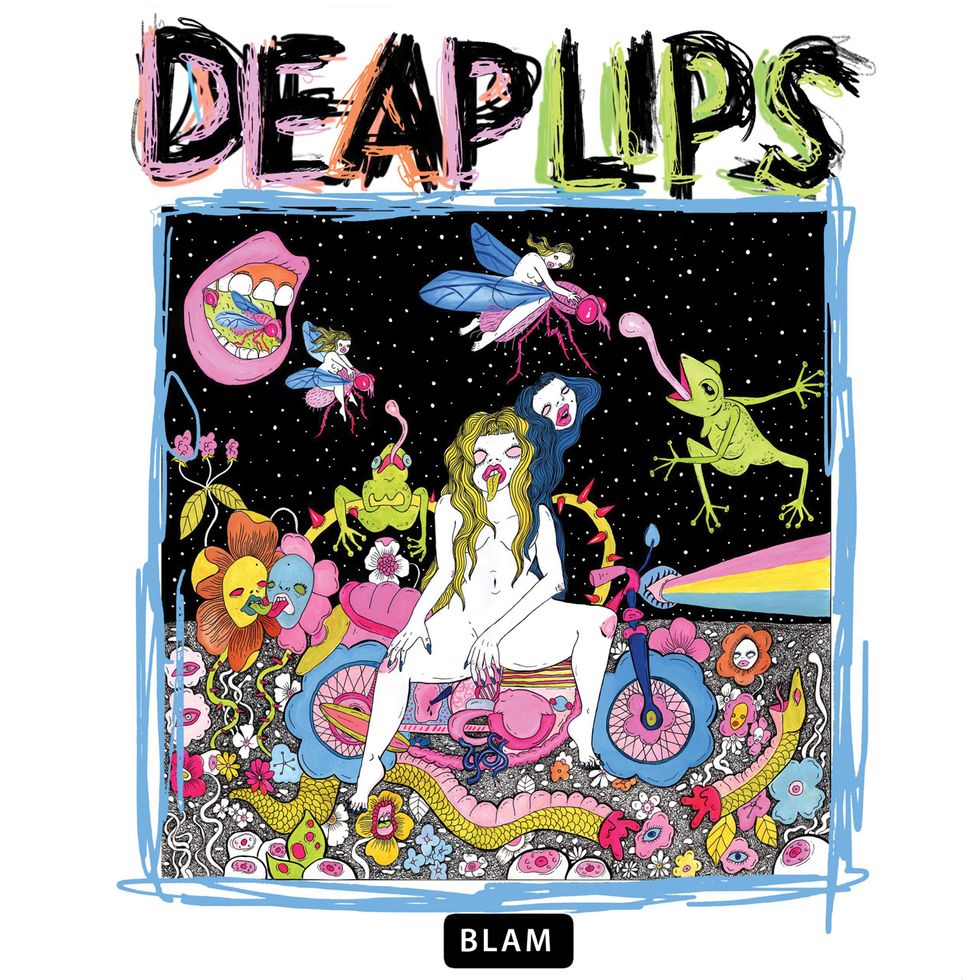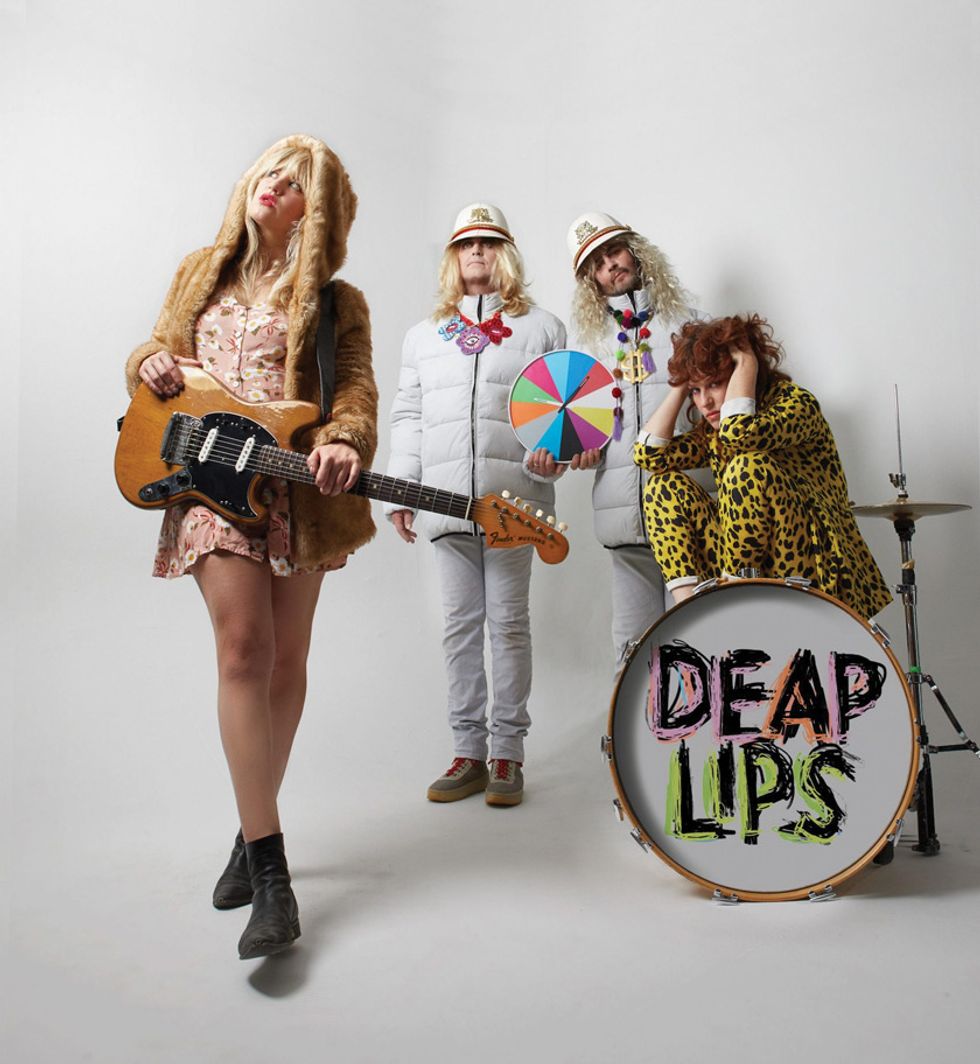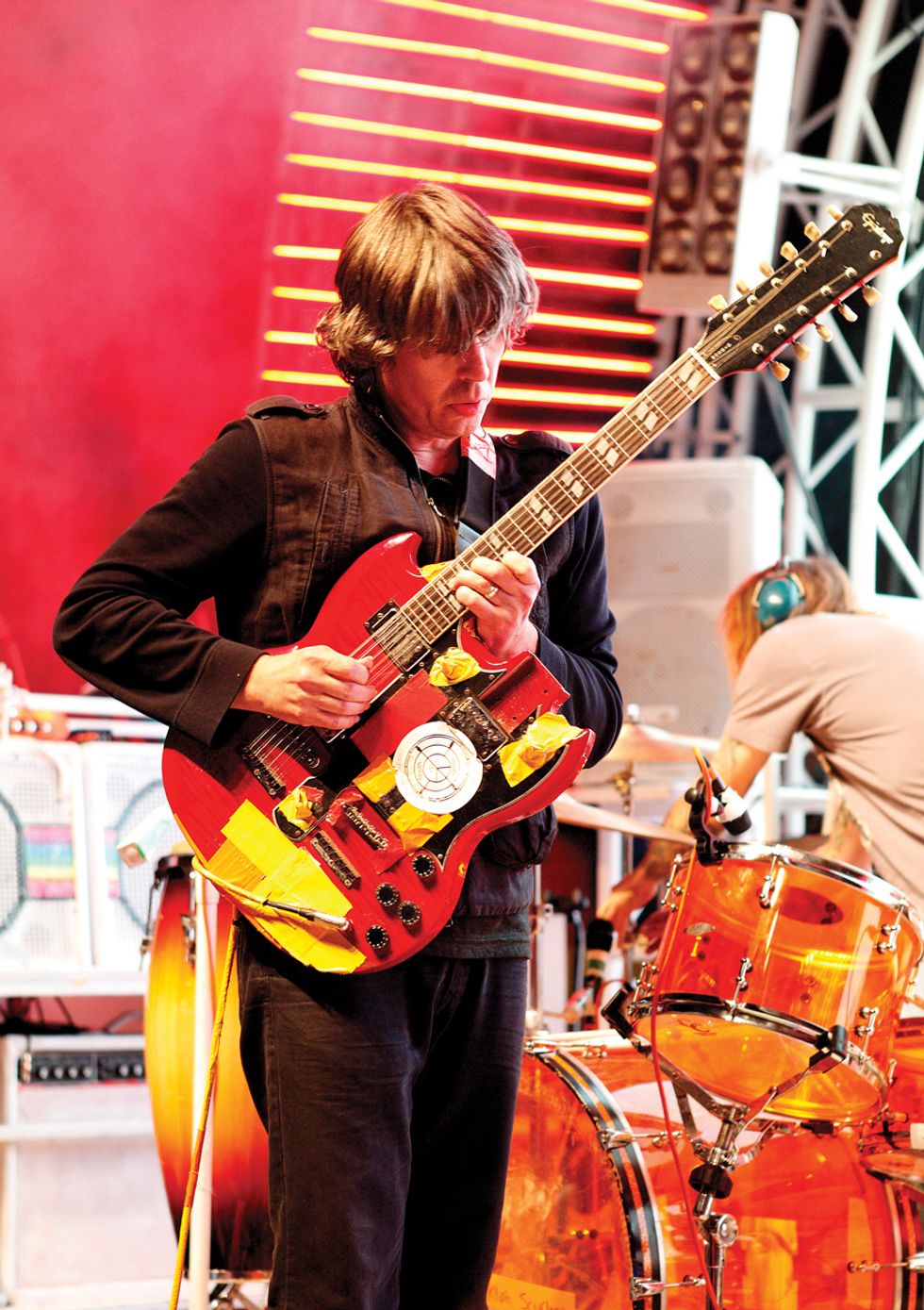Motorcycles and laser beams introduce a fuzzed-out mid-tempo riff to kick off the technicolor musical epic “Home Thru Hell,” the first track on Deap Lips, the new collaborative project from Deap Vally and the Flaming Lips. The song’s lyrics have fantastical tendencies alluding to classic prog-rock fare such as vultures and hypnotizer’s spells, while lines like “Riding along through the deep valley/Where the dragons of madness roam” and “Taking all my wisdom/From the flaming lips of youth” creatively shout out the band names of the two groups involved in this super-collab. “Home Thru Hell” acts as a bold and brilliant overture for an album that is brimming with fun and off-the-wall musical treats, including light rapping, robot voices, a Steppenwolf cover, and wild synth and guitar tones throughout.
Listening to Deap Lips, it’s easy to hear the musical characteristics of both Deap Vally and the Flaming Lips, but each band’s sounds have been so well-kneaded into the musical dough of this project that the album came out of the oven sounding truly original. It’s no surprise that this crew could cook up something fresh as both bands are seasoned collaborators: The Flaming Lips are well-known for working with a wide range of artists, from Miley Cyrus and Kesha to Mick Jones and the White Stripes, while Deap Vally have been working on a collaborative album with artists such as KT Tunstall, Peaches, and members of bands like Warpaint and Queens of the Stone Age.
As a guitar and drum two-piece, Deap Vally have just the right amount of room in their sound for two Flaming Lips to join in with synthesizers, bass, some guitars, and a handful of songs. Guitarist Lindsey Troy explains, “When you’re in a two-piece, people are always asking, ‘Will you add a third member?’ So this is our way of experimenting with that. It was fun to throw someone else in the room to change up the dynamic and it’s been great. We just thought we’d do one song with the Flaming Lips. We didn’t know it was gonna turn into a whole record, but it’s amazing that it did.”
It took some kismet for the two bands to come together. In 2016, Wayne Coyne was in Raleigh, North Carolina, meeting with the creator of the “World’s Largest Gummy Bear” about making some props for the Lips when he checked out a show by Wolfmother, where Deap Vally was opening. He tracked down Lindsey at the merch booth and the two hit it off immediately. It was only a matter of time before Lindsey hit up Coyne with the proposal to work on some music together, and in early 2018 she and drummer Julie Edwards were on their way to Wayne’s home studio, Pink Floor, to work with Coyne and fellow-Lip Steven Drozd. “We went out to Oklahoma City and stayed with Wayne at his house and wrote and recorded for five days, had a really great time, made some awesome stuff,” says Troy. “After that, he kept sending us more ideas and was eventually like, ‘Let’s do a full album.’ He’d send us stuff and we’d go into the studio in L.A. and send him stuff and that’s how the rest of it got finished.”
We caught up with Troy and Drozd to get both sides of the story behind the songwriting, gear, and guitar sounds on Deap Lips, and made sure to ask if the two bands will ever come together for a live tour.
Once Deap Vally arrived in Oklahoma City at Wayne’s house, how did you all get started on this record?
Lindsey Troy: It’s kind of funny. We’d already done several of these collaborations and the way we approached them in the past was that we’d just go into a room and start jamming on ideas in the studio and create a song that way. That’s what we were expecting to do with the Lips, so we didn’t really bring anything. But they were like, “We don’t really write that way,” so they had a couple things prepped for us, which was cool. We weren’t expecting that.
One night, we went into the studio and Julie and I were on our instruments and Wayne played around with some beat machines and we found some riffs that way. So we brought those to Steven and he wrote more parts and fleshed them out.
Steven Drozd: It’s a strange thing. I think maybe people have an impression of how these things usually go and for us it can go so many ways. I heard their music just a few days before, because Wayne wanted me to come to the studio and work with them. Besides the Flaming Lips, Wayne’s always got art and other stuff going on, so when he told me he was interested in trying to make music with this band, I wasn’t that surprised. We’re always working on music that might not work for the Flaming Lips but could work for someone else, so I had that in mind already.
I met them and we hit it off pretty well and it turned out that Julie’s brother [Greg Edwards] and I made some music together way back when in the ’90s. He was in a band called Failure that toured with us in 1994. It was pretty easy getting to know each other.
The thing that I was into immediately is that their music is really visceral—it’s riffs and energy. I thought this could be a cool mix of us doing some of our more ornate musical things and them doing some of their more raw, riff things, and it seems like it kind of mostly went that way. It was great from the get-go.
How many tracks did you do together in Oklahoma City?
Troy: We did four. It was “The Pusher,” “There Is Know Right There Is Know Wrong,” “Home Thru Hell,” and “Shit Talkin.”

TIDBIT: Four of the 10 tracks on Deap Lips were made with all band members present at Wayne Coyne’s home studio in Oklahoma City. The remaining songs were curated through Coyne and Steven Drozd in Oklahoma exchanging song ideas back and forth with Deap Vally’s Lindsey Troy and Julie Edwards in L.A.
Drozd: Wayne had a few things and “The Pusher” is something I started in my studio at home. I didn’t get very far because I couldn’t find a cool way to do the vocals that I liked. I think it turned out really well with Lindsey’s voice.
“There Is Know Right There Is Know Wrong” is based on a riff of a song of Wayne’s nephew’s [Dennis Coyne, of Stardeath and White Dwarfs] from years ago, and I built a new chord structure for a bridge and chorus.
One thing Wayne wanted to do was have Lindsey set up her thing and have Julie set up her thing and just record them and see what it felt like. Most of the main riffs are basically them. “Home Thru Hell,” that’s Lindsey and Julie together. There’s a bunch of other stuff on it, but that’s basically them.
How did you end up doing a cover of Steppenwolf’s “The Pusher”?
Drozd: You know, I just get these weird ideas. I heard “The Pusher” by Steppenwolf on the radio—it’s a Hoyt Axton song but Steppenwolf had the hit with it. There are elements of the song that are so amazing. It’s so dark and fucked up and weird. I thought, wouldn’t it be cool if a band like Kraftwerk did a version of “The Pusher?” Like, this cold, electronic version that doesn’t have the bluesy solo and it’s all cold and drum machine-ish. It just started like that.
Troy: It was cool. It’s a classic-rock song, but it’s so wildly different from the original. Basically, only the lyrics are the same—the music is different and the melody is different.
Speaking of vocals, on “Motherfuckers Got to Go” you rap a little at one point, which is kind of different than other Deap Vally stuff.
Troy: That song was definitely kind of a weird one, but it ended up coming out kind of cool. It’s very repetitive but it works because it’s anthemic. We’ve played around with vocals like that a little bit in the past, so we were down for it.
Steven Drozd plays a heavily dismantled Epiphone doubleneck onstage with the Flaming Lips at the Fillmore Detroit. Drozd stuck to his ’67 Jazzmaster for several Flaming Lips’ albums, but “just kept getting weirder and weirder” with experimenting over the years. Photo by Ken Settle
How did it work for you to trade tracks once you got back to L.A.?
Troy: Wayne was texting us stuff. I experimented with recording some vocals. He was like, “Record some vocals on your phone; it’s not a big deal.” So I recorded some stuff on a voice memo and sent them back and I think they used some of those for “Not a Natural Man,” but for the rest of them, they were too lo-fi and it wasn’t working so we went into a studio.
We sent some ideas over to them, but it wasn’t really clicking that way with Steven. He was more comfortable crafting ideas from Oklahoma City and sending them our way.
Can you give me some insight into how you chose what songs to work on remotely?
Drozd: A lot of that is Wayne just pushing through. I’d say, “That’s a cool riff, what do you want to do?” And he’d say, “I’m gonna work on it for a day and come back tomorrow.” He was mostly of the instigator for all of it really.
Sometimes we’d just start with he and I sitting there with a riff and he’d say, “I’m gonna work on this today and you come back tomorrow and we’ll get it to the next phase.” And then we’d send it to them.
It’s really like all our other stuff. You start working on something, you try to shape it into something that’s interesting to you, and I’m the kind of person that might get bored and throw it out, but Wayne, he’s a finisher. He’s gonna keep working on it.
Lindsey, for you, what’s the key to a cool guitar sound?
Troy: For each record, I have my sound. For our first record, my sound was pretty consistent throughout the whole record: a lot of Big Muff fuzz, octave pedal, delay, and some tremolo. For the second record, I started experimenting a little more with reverb and clean sounds that I hadn’t used on the first record.
I’m not into using a million pedals. I like to add a few for each record to keep it interesting for myself, but I don’t like too many because I like to have limitations to work with. Recently, I’ve been playing around with fuzz and clean tone. I have this really cool ZVEX Lo-Fi Junky. I’ve been using that a lot on my solos.
I just mess around until I find something that I feel is really powerful. I got to a point where I was starting to feel a little over the Big Muff because I use it so much. I was trying to find more clean tones and a middle ground between clean and the Big Muff, which is like turning it up to 11, and looking for a distortion more like from an amp. So I’ve been experimenting to find that sound, with overdrive pedals and stuff like that, changing it up enough to keep it interesting, but still keep my sound.

Guitars & Basses
Fender Telecaster Deluxe
Fender Precision bass
1960s Gibson J-160E
Rickenbacker 4001CS
Vintage Kay hollowbody
Epiphone G-1275
1967 Jazzmaster
Amps
Vintage Supro
Effects
Ampeg Scrambler Bass Overdrive
Various Soundtoys effects and plug-ins
Strings and Picks
Ernie Ball Skinny Top Beefy Bottom (.010–.054)
Fender Medium

Guitars
1970s Fender Mustang
Amps
Fender Deluxe ’65 Reissue
2012 Fender Bassman
Effects
Boss OC-3 Super Octave
Boss TR-2 Tremolo
Electro-Harmonix Big Muff
ZVEX Instant Lo-Fi Junky
Strings and Picks
Ernie Ball (.011–.052)
Dunlop Tortex .93 mm
I tend to write really riffy. Steven uses a lot of chords and crafts songs in a very Beatles-esque way. I feel like, as a two-piece, to use chords all the time and to not have a bass player is not that great, so I try and use riffs to keep it interesting and I can use the octave pedal to add a bassy-ness.
Drozd: That is true. She played all the real cool, simple riffs and I probably came up with the chord progressions, and if not me, it was Wayne. One thing I don’t like about my stuff is that it sometimes loses that visceral feeling and Lindsey’s got these super simple riffs and sometimes you can have the riff play and then go through a structure of chords and sometimes you can have the riff play with the structure of chords underneath it.
I always love the guitar and bass sounds on Flaming Lips records. What’s the key to a good guitar sound for you?
Drozd: There’s a bunch of different ways it could go. I find myself preferring cleaner, more traditional, Jimmy Page on Houses of the Holy or Steve Howe kind of sounds and then going from there. Or just completely synthetic from the beginning, like running through a fuzz or a ring modulator.
I do gravitate toward more noodle-y guitar things. Wayne, he’ll come up with something that’s more badass and simple, but I usually get more hung up on, “If I play this Fmaj7 in this position, how’s it different than if I play it up here? How does that work?”
There’s been a few main guitars I’ve used over the years, but that’s changed again in the last couple years. For a while, I only used that ’67 Jazzmaster. Most of The Soft Bulletin is that and a ’67 ES-330. By the time we got to Yoshimi, it was the Jazzmaster and Dave Fridmann had a baritone made by Silvertone. When we got up to Embryonic, I got this crazy Fender electric 12-string, a ’75 Telecaster, a ’67 Gibson Explorer, and just kept getting weirder and weirder.
At home, half the time I don’t even use an amp, I just use the UAD [Universal Audio] plug-ins with virtual amps.
Steven, can you give me a rundown of the gear you used on Deap Lips?
Drozd: All the guitar stuff recorded at Pink Floor is Lindsey’s Mustang or we have a Telecaster Deluxe and an old Kay hollowbody, so one of those three guitars going through a really small Supro amp mic’d up with a ribbon mic. It’s a really small amp from the ’60s or ’70s with one 10-inch speaker. There’s reverb and tremolo built in. Whatever you do with it, it always sounds great. The acoustic stuff is a Gibson at Wayne’s studio.
Most of the bass stuff was done direct, right into Pro Tools. Wayne would either plug in to some kind of fuzz box or pedal and then go right into a DI into Pro Tools. All the keyboard stuff is just different soft synth plug-ins. We use a lot of Arturia stuff—Rhodes-y kind of keyboards and synthesizers. And we use Miroslav to create orchestral textures. We’ve been doing that for a long time. It’s half and half with Michael’s [Ivins] old Fender Precision that he’s had since the ’80s, or a Rickenbacker 4001CS that we bought 15 years ago.
We used the Ampeg Scrambler a lot. We have so many stompboxes and stuff. There’s just so much different stuff. The way we work, we’re just so all over the place and we have a lot of pedals and use a lot of plug-in effects, too. All that stuff from Soundtoys is pretty kickass. There’s just so many options for things.
Lindsey Troy’s natural finish ’70s Fender Mustang was the first electric she ever played, and it remains her No. 1 guitar. Photo by Sara Amroussi-Gilissen
Lindsey, when you were at Wayne’s house, were you using your gear or the stuff they have?
Troy: I was using my guitar, but Julie was making beats with some of their really weird equipment. In “Home Thru Hell,” there’s this weird high-pitched Nintendo sound, that was some weird analog thing they had and she used.
I used my Big Muff, I used the Boss OC-3 octave pedal, and I used a tremolo pedal. That’s stuff that I brought. I have a Fender Deluxe and Bassman, but when I’m in the studio I’ll play around with what they have there.
Do you think Deap Lips will ever play live?
Troy: In theory, it would be awesome and we have talked about doing some dates where Deap Vally would open for the Flaming Lips. We’d each play a set, and a portion of the show would be Deap Lips stuff. Now, who knows? But hopefully, we’ll eventually do something live.
Drozd: Wayne and I have definitely talked about if the Lips were going to do a tour and we could create this Deap Lips band. It wouldn’t have to just be the four of us; it could be whoever, and we could open up for us. We did that with the Electric Würms for a couple of tours and it was stressful, but it was also fun. It sounds like a cool idea to me!
Dig the fuzzy tones guitarist Lindsey Troy gets from her Fender Mustang as she and drummer Julie Edwards rock out on Deap Vally’s slow and bluesy “Royal Jelly” for Jam in the Van at SXSW 2016. The main riff of the tune is an exercise in sparse, single-note simplicity while the duo kick out the jams on the choruses.















![Rig Rundown: Russian Circles’ Mike Sullivan [2025]](https://www.premierguitar.com/media-library/youtube.jpg?id=62303631&width=1245&height=700&quality=70&coordinates=0%2C0%2C0%2C0)











![Rig Rundown: AFI [2025]](https://www.premierguitar.com/media-library/youtube.jpg?id=62064741&width=1245&height=700&quality=70&coordinates=0%2C0%2C0%2C0)




















 Zach loves his Sovtek Mig 60 head, which he plays through a cab he built himself at a pipe-organ shop in Denver. Every glue joint is lined with thin leather for maximum air tightness, and it’s stocked with Celestion G12M Greenback speakers.
Zach loves his Sovtek Mig 60 head, which he plays through a cab he built himself at a pipe-organ shop in Denver. Every glue joint is lined with thin leather for maximum air tightness, and it’s stocked with Celestion G12M Greenback speakers.











